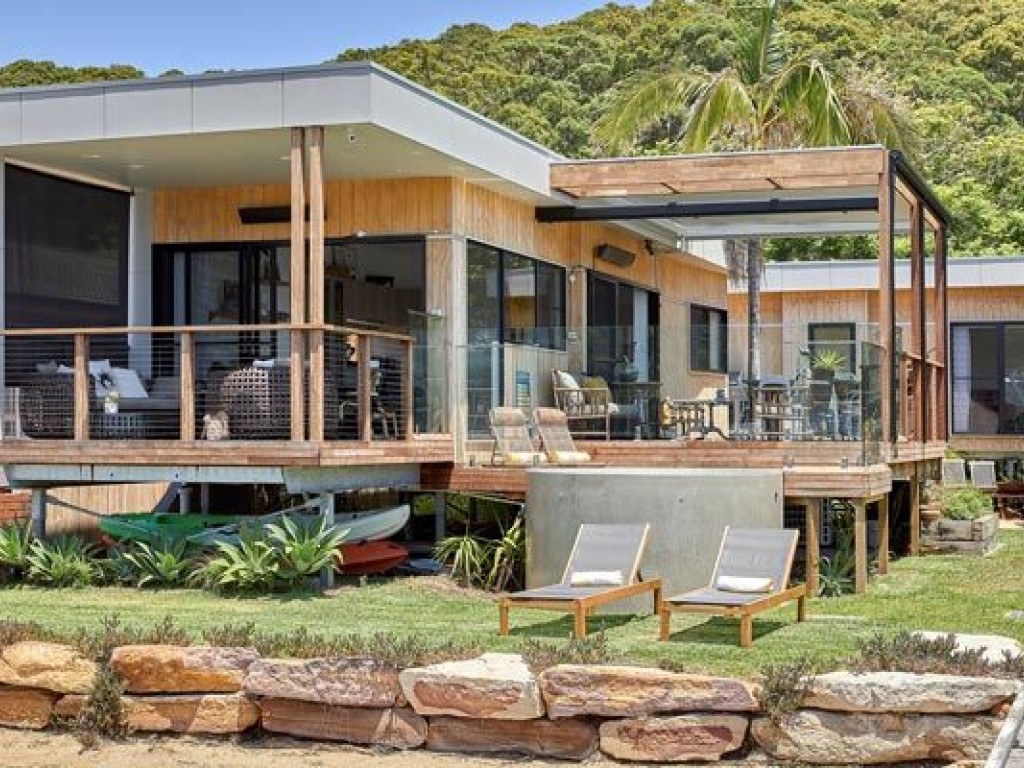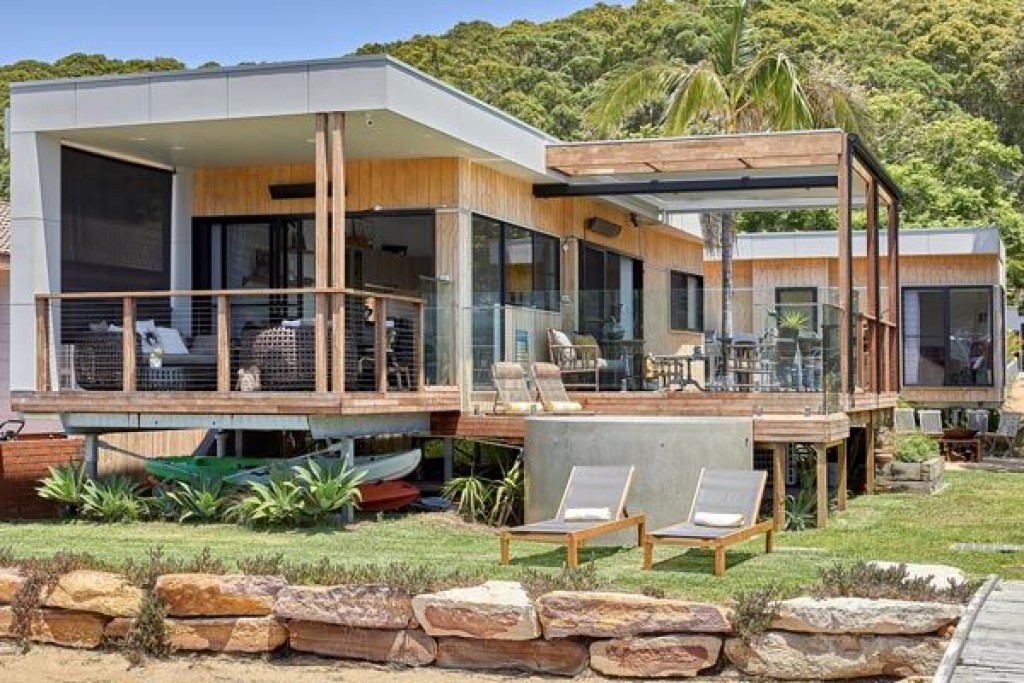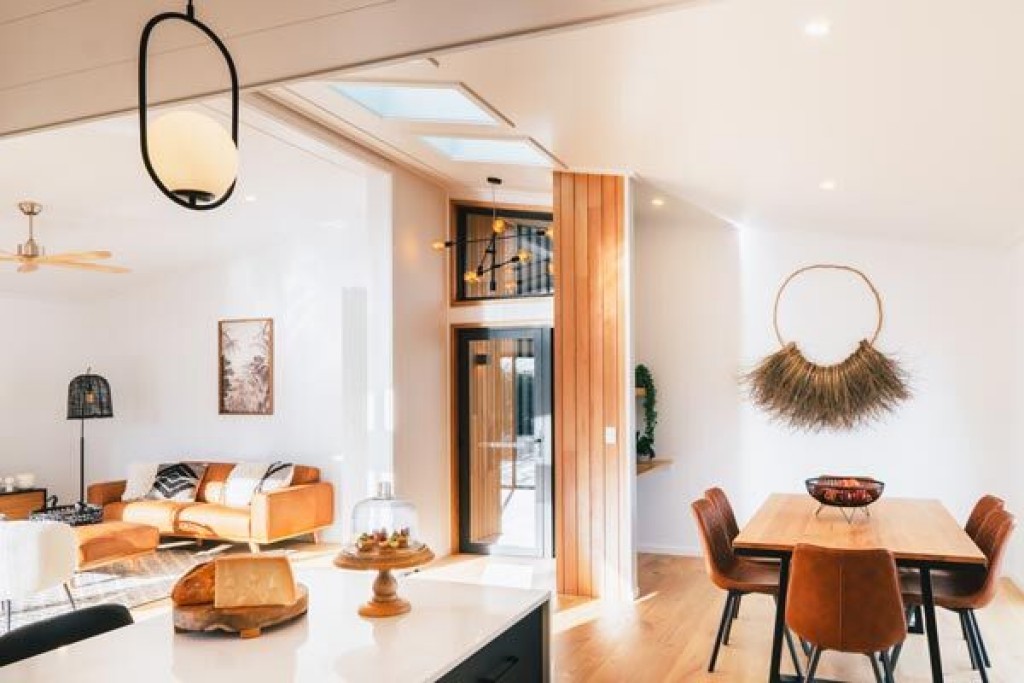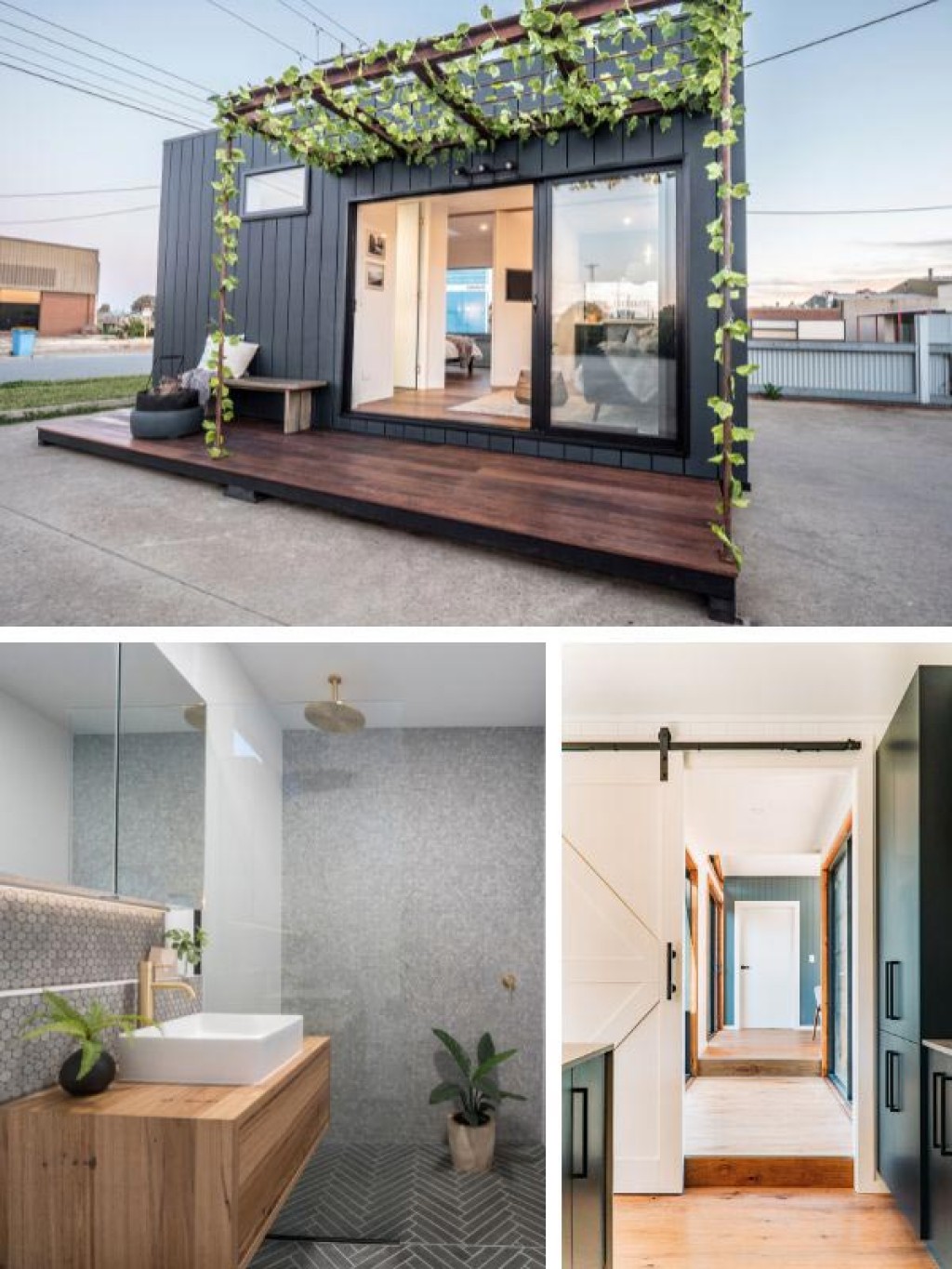
Are ‘innovative’ prefab homes the answer to the housing crisis?
Factory-built homes avoid the delays, high costs and frustrations of on-site construction, so what is the catch?
Australia's housing woes may go down as the crisis the nation couldn't build its way out of - unless something changes fast.
It's been two years since government and industry came together to launch the National Housing Accord, initially targeting one million new homes between July 2024 and July 2029 - an increase from about 934,000 approvals in the previous five years.

innovative_02
A crane lowers a Prefabulous building into place, and (right) a JMB Modular Buildings home. Source: Supplied.
By August 2023, the goal was revised upward to 1.2 million homes, with a $3 billion New Home Bonus giving States and Territories $15,000 per housing approval beyond the first million. The payment
will start in 2028.
But even with incentives, we're already behind.
In December 2024, approvals totalled 15,174 - around 5000 below target. Since mid-2024, only 89,734 homes have been approved, well short of the 120,000 needed. By 2029, Master Builders Australia estimates Australia will miss the target by 167,000 homes. So, at this rate, business as usual won't resolve the crisis.
Housing supply isn't just about approvals - it's about how long it takes to get a home from planning to completion.
Fifteen years ago, building a house took around nine months. Now, according to the Australian Bureau of Statistics (ABS), it takes 12.7 months - a 40% increase.
For apartments, delays are even longer. Over the same period, build times have stretched from 18.5 months to 33.3 months - an 80% increase.
Denita Wawn, chief executive of Master Builders Australia, cites labour shortages, declining productivity, union agreements, supply chain disruptions, regulatory hurdles and infrastructure delays as key issues.
"With advancements in technology and construction methods, we should be building homes faster, not slower," she said in November 2024.
Yet traditional construction remains vulnerable to delays at every stage.
Materials must be delivered to sites, weather can cause weeks-long setbacks and skilled trades must be available in the right order. One hold-up cascades into another.
What are modern prefab homes?
Prefabricated homes avoid these bottlenecks. Built in a factory under controlled conditions with materials and workers in place, prefab reduces many of the delays that plague on-site construction.
Grant Cairns, executive general manager of business lending at CommBank, says off-site construction isn't weather dependent, runs year-round and allows multiple builds at once.
While a traditional home can take a year or more to complete, he says a factory-built home can be ready in just 10 to 12 weeks.
"These innovative building techniques can significantly improve productivity and the speed with which houses are built."
The recent Federal Budget included $49.3 million worth of funding for state and territory governments to invest in the prefab and modular housing industry.

innovative_03
A prefab home by Parkwood Modular Buildings. Source: Supplied.
What is the biggest hurdle of buying a prefab house?
While prefab buildings are common in sectors such as education and healthcare, residential homes remain under-represented, says Damien Crough, executive chair of prefabAUS, the peak body for off-site construction.
He says financing has been the biggest hurdle.
With traditional on-site construction, banks release funds in stages as the build progresses. At each stage, they assess the land and the partially built home as security for the loan. This step-by-step funding model gives lenders confidence to continue financing the project.
Prefab homes, however, don't follow this process. Since the construction happens off-site in a factory, lenders can't assess progress in the same way. As a result, banks don't consider the off-site build as security, leaving customers to mostly fund the build.
According to Christian Stevens, chief executive of mortgage broker Flint, consumers would typically either have cashed out equity on land to fund the construction or use cash for the build and then refinance once complete.
"Neither option will stack up for most clients, especially first-home buyers."
Stevens has seen these challenges first-hand with his own clients. Securing funding for modular housing projects has been difficult under current lending policies, he says, forcing brokers to work closely with lenders' construction and risk teams to push for policy updates.
"The issue for my client is that he already has a loan on his land," says Stevens. "Under current modular housing policies, there's almost always a shortfall when trying to finance the build, making it unachievable."
What makes the situation even more frustrating is that his client has no trouble affording the repayments. Yet, because of outdated lending restrictions, financing a prefab home remains out of reach.

innovative_04
Top: A JMB Modular Buildings project. Bottom left: Inside a Modscape home. Bottom right: The bedroom of an AuscoModular prefab house. Source: Supplied.
How are prefab homes funded?
For CommBank's Cairns, prefab's biggest barrier is the status quo.
"Everything about construction has been created with traditional, on-site work in mind."
To address this, CommBank joined prefabAUS in becoming its first bank member in January.
The bank is sponsoring a standard-form prefab contract, expected by Easter, which unlocks funding earlier in the process, reducing the out-of-pocket costs for customers.
For prefab contracts valued at $1.5 million or less, CommBank can release progress payments before the dwelling is installed on-site, up to the following limits:
- 120% of land value or 60% of the contract price - all customers;
- 150% of land value or 80% of the contract price - customers of approved prefab builders.
This is a significant shift from current policies, where buyers often need to fund up to 90% of the cost themselves.
Cairns says the bank can now do this because these new contracts consider that prefab construction significantly reduces two key risks facing builders: the risk of cost escalations - from materials inflation and labour shortages - and the risk of delays.
For homebuyers, Cairns says these contracts also offer clear terms and protections, reducing the risk of unexpected costs and disputes.
"They include safeguards such as defects liability periods, structured process for variations and progress payments tied to construction milestones, ensuring greater transparency and security through the build."
By partnering with accredited prefab manufacturers, CommBank hopes to ease borrower concerns as well as its own.

innovative_05
Inside a Prefabulous project. Source: Supplied.
What is the quality of prefab homes like?
Mortgage brokerage Stevens notes a common perception that prefab homes may not retain value as well as traditional builds, raising resale worries. Additionally, lenders generally remain cautious due
to the varying stability and reputation of manufacturers.
PrefabAUS director Damien Crough says there was good reason why there was a stigma about prefab housing in the past, because of a lack of quality and non-compliance. However, this has changed
in the past decade with the emergence of digital tools.
"Robotics, digital twins, automation and all these amazing technologies have made its way into prefab housing," he says. "And the transfer of skills and knowledge from other sectors like automotive and aerospace has helped us along."
Of course, the market for cheap alternatives still exists. "You can jump online and purchase a cheap and nasty prefab, the same as you can buy a cheap and nasty car."
"But we aren't advocating for tiny homes or containers and other temporary non-solutions. We're talking about high quality, Australian-made, National Construction Code-compliant real housing solutions."
With prefab manufacturers becoming more legitimate, Crough says many have building licences and will do the full turnkey. "Most have an off-the-shelf design and after you sign the contract they'll coordinate the site services," he says. "The footings, planning permits, plumbing, electricity, internet and gas lines are installed while the home's getting built."
For consumers, Stevens says due diligence is essential but there are many reputable prefab manufacturers.
"When I think about modular housing, I think of architecturally designed properties that allow accelerated construction - not shipping containers with windows."

innovative_06
Top and bottom left: A JMB Modular Buildings project. Right: Inside a Prefabulous home. Source: Supplied.
Are prefab homes used overseas?
Internationally, Australia lags in prefabricated construction. In Japan, prefab units make up 12.6% of new builds, driven by sustainability and disaster resilience.
This market is dominated by divisions of manufacturing companies not known elsewhere for houses, such as Panasonic, Mitsubishi and Honda.
"The Japanese aspire to own a Toyota home because, much like a Toyota car, they may not be the fastest or look the best, but they last," says Crough. "Some Japanese prefab homes even have 25-year warranties."
Sweden also offers a compelling model. Harsh winters, with temperatures plunging below -20°C, have driven 45% of new home builds to use offsite manufacturing. Australia's climate - baking summers, fires and floods - presents the opposite challenge, but the logic remains: prefab ensures efficient, year-round construction.
Locally, prefabAUS estimates Australia's 1190 prefab companies across the supply chain make up just 8% of total residential and commercial construction.
But that share could jump to 30% by 2033, according to Crough.
With the Federal government exploring regulatory reforms, launching a prefab handbook aligned with the National Construction Code in November and prefabAUS establishing an industry roadmap, the sector's future looks promising.
But while CommBank's recent policy update is a step in the right direction, mortgage brokerage Stevens says significant work remains for prefab to become mainstream.
"Clearer regulations, public education on the benefits and quality of prefab homes and government incentives would drive investment, shift perceptions and boost demand for prefab housing."
Still, for consumers, the possibility of building a prefab home is becoming easier to achieve in Australia.
First-home buyer gets 'more for my money'
When Lawrence, 39, set out to buy his first home with his partner in Creswick, Victoria, he faced the same challenge as many Australians: affordability.
So, he turned to a prefabricated home. "We were budget constrained like every first-home-buying couple," says Lawrence. "We found that factory-built homes are significantly more efficient to construct and are competitively priced."
He also wanted practicality. His prefab home, built on stumps, allowed for future renovations and better weather protection. Lawrence says building a prefab home follows a similar permit process as traditional construction but is much quicker. "Once it hit the site, the house was 'finished' inside a week. Factory time was about six weeks, but there was a bit of a wait for a build slot."
Since moving in, he's been impressed with its energy efficiency, noting an ACH50 (airtightness rating) of 5.7, far better than the nine to 14 range of most new homes. "If your ACH50 is above 10, you may as well leave the doors open."
His 125sqm, three-bedroom home is heated and cooled with a single 5kW reverse-cycle split system.
A building surveyor, Lawrence routinely inspects prefab homes and says they are better than many on-site constructions.
"They're structurally stronger because they need to withstand relocation," he says. "Factory-built homes pass inspections the first time almost twice as often as on-site builds. The controlled environment means no weather delays, extra staff when needed and better supervision."
However, he warns about box gutters and flat-roof designs, which are "maintenance nightmares".
"A lot of suppliers go for flat roofs to maintain transport height."
For Lawrence, the benefits of prefabs far outweigh any drawbacks, especially for buyers on a budget.
Source : Money Magazine
Author : Ryan Johnson

